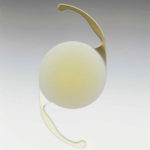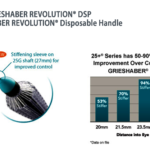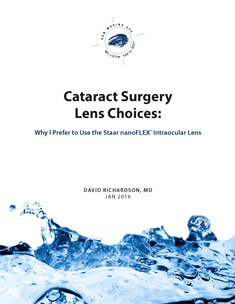In my previous post I summarized the results of a study performed by Dr. William Trattler and associates. Today I would like to dig a little deeper into the “real-life” experience of surgeons who use these lenses. In order to make this post as useful as possible to my readers, I am not just going to relate my own experience. Rather, I have chosen to relate the experience of another well-respected Los Angeles cataract surgeon (on the “other side of town” – the Westside).
Like Dr. Trattler, Dr. Uday Devgan is a paid consultant of AMO. Also like Dr. Trattler, I respect his opinion and have chosen (with his permission) to relay it to you:
ReStor® +3 (SN6AD1)
- This IOL has a +3 add on anterior (front) surface of the IOL. This translates to about +2.25 at spectacle plane (what would be placed in bifocal glasses). In other words, the strength of this IOL is intermediate vision (computer use, arms-length work, shopping).
- Diffractive rings are located in the central 3mm of the optic. This makes the IOL “pupil dependent”. In other words, the IOL is distance dominant for larger pupils and near dominant with small pupils. What does this mean? Practically, it means that there should be good night-time vision with minimal halos noted (though they will be there, most people do not find them too bothersome); and that reading will require a good source of light in order to keep the pupil small.
- The IOL has ayellow chromophore (tint) intended to protect the retina from “harmful” blue wavelengths of light (note: the benefit/detriment of the filter is controversial)
- Optimal near point of about 17-18 inches (the distance from your eyes at which you can expect to have the best near vision – see above comments about intermediate vision)
Tecnis® Multifocal (ZMB00)
- This IOL has a+4 add on posterior (back) surface of the IOL. This translates to about +3.00 at spectacle plane(what would be placed in bifocal glasses). In other words, the strength of this IOL is near vision (reading books, threading needles, etc.)
- The diffractive rings are located throughout entire optic. This makes the IOL “pupil independent”. In other words, the near and far vision are equally good at all pupil sizes. Practically, this means that it should be easier for patients to read in dim lighting but that halos may be more bothersome with night-time activities such as driving.
- The optic does not have a “blue-blocking” tint. Again, there is controversy regarding whether this is a good or bad thing (see my earlier posts on this topic).
- Optimal near point of about 13-14 inches (near activities)
Dr. Devgan also notes that since the central 1 mm of the Tecnis® Multifocal IOL is pure distance, it tends to give great vision for daytime activities such as golf, daytime driving, etc without any complaints of waxiness.
Dr. Devgan can be reached at:
Devgan Eye Surgery
11600 Wilshire Blvd, Suite 200
Los Angeles, CA 90025
800-337-1969
www.DevganEye.com








I had the restor lens put into my first and worse eye after Cataract surgery and couldn’t read at all out of my left eye. Later I had the second, right eye done with the Tecnis multi focal lens and I have had not one bit of trouble reading tiny little print. In about a week I am having the restor lens in my left eye replaced with the Tecnis. I hope that this will solve my problem.
Dina Richter
@Dina Richter;
I had cataract surgery on my left eye with AcrySof IQ ReSTOE(multifocal) 6 weeks ago. The vision of operated eye is still 20/80 and blurred. It is exactly the same as post surgery, but worse than before. The surgeon said it is because of my dry-eye symptom. I like to know how it went after your replacement surgery.
Question;
If the problem really is because of dry-eye (no other problem was found), shouldn’t my sight be improving even a little each day (it’s been 6 weeks!)? Could the problem be the lens itself?
Multifocal IOLs are, indeed, very sensitive to any sort of Ocular Surface Disease (OSD – of which Dry Eye Syndrome is the most common). OSD often worsens after any type of eye surgery and this is thought to be due to the frequent use of preservative-containing eye drops. This worsening OSD tends to last for one to two months but can persist for as long as six months (especially after LASIK). Most of the time it can be treated with a combination of preservative-free artificial tears, punctal plugs, Restasis, and oral omega-3 fatty acid supplementation. If it doesn’t improve over… Read more »
Hi- I am having cataract surgery in 4 weeks and need to decide between the Restore and the Technis. I am 37 and have large cataracts in both eyes. No other medical problems. What is the best lens?
I would not describe either lens as better than the other. Each has its upsides and downsides. In general the following can be said about these lenses: Alcon ReSTOR +3 IOL Near “sweet spot”: Intermediate vision (requires bright light to read at near) Halos: expected at night around point sources of light (but less so than with the Tecnis Multifocal IOL) AMO Tecnis Multifocal IOL Near “sweet spot”: Reading vision (does not require bright light to read) Halos: expected at night around point sources of light (more notable than with the Alcon ReSTOR +3) It really just depends on one’s… Read more »
Thanks for these great articles. I’m a 45 year old female. I had ICLs implantd about ten years ago for vision correction. I was not a candidate for LASIK because of my level of refractive error (-12/-13)) and my thin corneas. I’ve been very happy with my ICLs. They did not correct my astigmatism but I still was able to see well enough without any glasses or contacts. Now, however, I have cataracts and need to have the ICLs and my own lenses removed and IOLs implanted. I’m scheduled for surgery next week and I had opted for nanoflex lenses… Read more »
Meryl, I hope your lens choice worked out well for you. In general he ICL does not affect the measurements needed for accurate choice of an IOL. As you may be aware, I think the Staar Nanoflex has a number of unsung advantages over other currently FDA approved IOLs. That being said, I have placed the Lenstec Softec HD in those of my patients whose myopia was too severe to allow for implantation of a Staar Nanoflex IOL. Most of them have done very well with some added range of vision (though my impression is that the Nanflex provides for… Read more »
Technology is amazing. I rebemmer years ago when my grandmother had cataract surgery the lens were removed and she had to wear thick coke-bottle bottom lens (in rhinestone frames, of course). She also kept the surgically removed cataracts in a medicine bottle afterwards. Okay, my family is weird.
I do not know if I filled this reply out correctly, but read with interest your comments re: lens replacement. I did my left eye with a Restor lens SN6ADl (14.0 D +3.0 add)6 mos. ago and still cannot see 20/20 (maybe 20/30), cannot see intermediate (fuzzy) and of course can only read in bright light, but ghost images present). My choices now are do 2nd eye, wait for both to stabilize and then do PRK. Also recommended YAG laser on operated left eye. Does this help images improve, intermediate & near? If I opt to remove this lens, I… Read more »
“Fuzzy” vision after placement of a multifocal IOL can be multifactorial. Some of the more common causes (and their treatments) include: 1) Dry eye – Generally treatable. However, if this cannot be improved then IOL exchange would be indicated. 2) Residual refractive error (especially astigmatism) – Laser refractive surgery (PRK or LASIK) can usually take care of this. 3) Posterior capsular opacification (PCO) – YAG laser capsulotomy will improve visio if PCO is the limiting factor. However, once a YAG capsulotomy has been done, IOL exchance can be very challenging. 4) Inability to “neuroadapt” – Implanting a multifocal IOL in… Read more »
Thank you for your reply of nearly 1 yr. ago. Never did the Yag laser in left eye Restor lens. I was hoping for improvement, but having had several opinions, I see only about 20/40 distance, and some things @20/30. Smeared vision when trying to read, no matter how bright the light. Told that the lens is off by 1/2 diopter. I hesitate to do Yag because I think that if this isn’t enough to give me better vision, then must do PRK. I understand that sometimes this is not always successful. Also, would the PRK correct for distance and… Read more »
I’m afraid many of your questions cannot be answered without a direct exam (and a few would likely be left unanswered even with an examination). I can, however address some general truths about the ReSTOR IOL: – The ReSTOR is rather unforgiving when it comes to residual refractive errors. A 1/2 diopter may not seem like much, but it can be enough to limit the range of uncorrected vision with a multifocal IOL. – Ditto for posterior capsular opacification (PCO). What would be an insignificant opacification for a monofocal IOL can really “smear” the vision with a multifocal IOL. The… Read more »
Hi DrDavid, Thanks so much for your Feb. 16th reply. You explain everything in a way that I can understand. I don’t mind saying that I feel like I am at the crossroads of my life with my eyes. My right (Nanoflex) is very fuzzy now because I really need to get the Yag done. It was 20/20 for several weeks after surgery and now it is 20/25. I agree with you that the Nanoflex is a good lens, good, clear vision in the beginning, and if I remember correctly, my intermediate was also good. Computer inward was not, but… Read more »
Norma, Again, I’m afraid many of your questions cannot be answered without a direct exam or would likely be left unanswered even with an examination. It is simply not wise or possible to answer questions in the format of “What should I do?” or “What would happen if…?” I will do the best to address those questions I can. Question: “Is it true that sometimes even YAG and/or PRK does not always make a difference with multifocal lenses?” Answer: That is correct. Multifocal IOLs are very demanding in the sense that they require minimal residual refractive error, good ocular surface,… Read more »
Topic: Tecnis Multifocal IOL My experience with the Tecnis Multifocal lens: Job: Software Engineer: Computer use 8-10 hours a day. Age: 47 Gender: Male Lens recommended based on occupation, age and lifestyle. Lens was pitched as the best lens available. Left Eye: Lens: ZMA00: Diopter +18.0D+4D t13mm, b6mm Surgery Date: Initial: 2-21-12 Surgery Date: Reposition: 3-10-12 Outcome as of 5-12-12: 1) Left corner of eye has annoying edge glare. 2) Halo’s around light sources both day and night. 3) Ghosting of text and transition between light and dark objects 4) Shimmering affect when scanning down a printed page. 5) Reading… Read more »
[…] 17.AMO Tecnis Multifocal vs. Alcon ReSTOR +3 Advanced Technology … Today I would like to dig a little deeper into the “real-life” experience of … Also like Dr. Trattler, I respect his opinion and have chosen (with his permission) to relay it to you: … The IOL has ayellow chromophore (tint) intended to protect the retina from … -Optimal near point of about 17-18 inches (the distance from your eyes at … http://www.about-eyes.com/?p=710 […]
[…] if you want your insurance to cover the entire tab for your surgery, a standard monofocal IOL will be your best choice, but expect to wear glasses after surgery for both distance and near […]